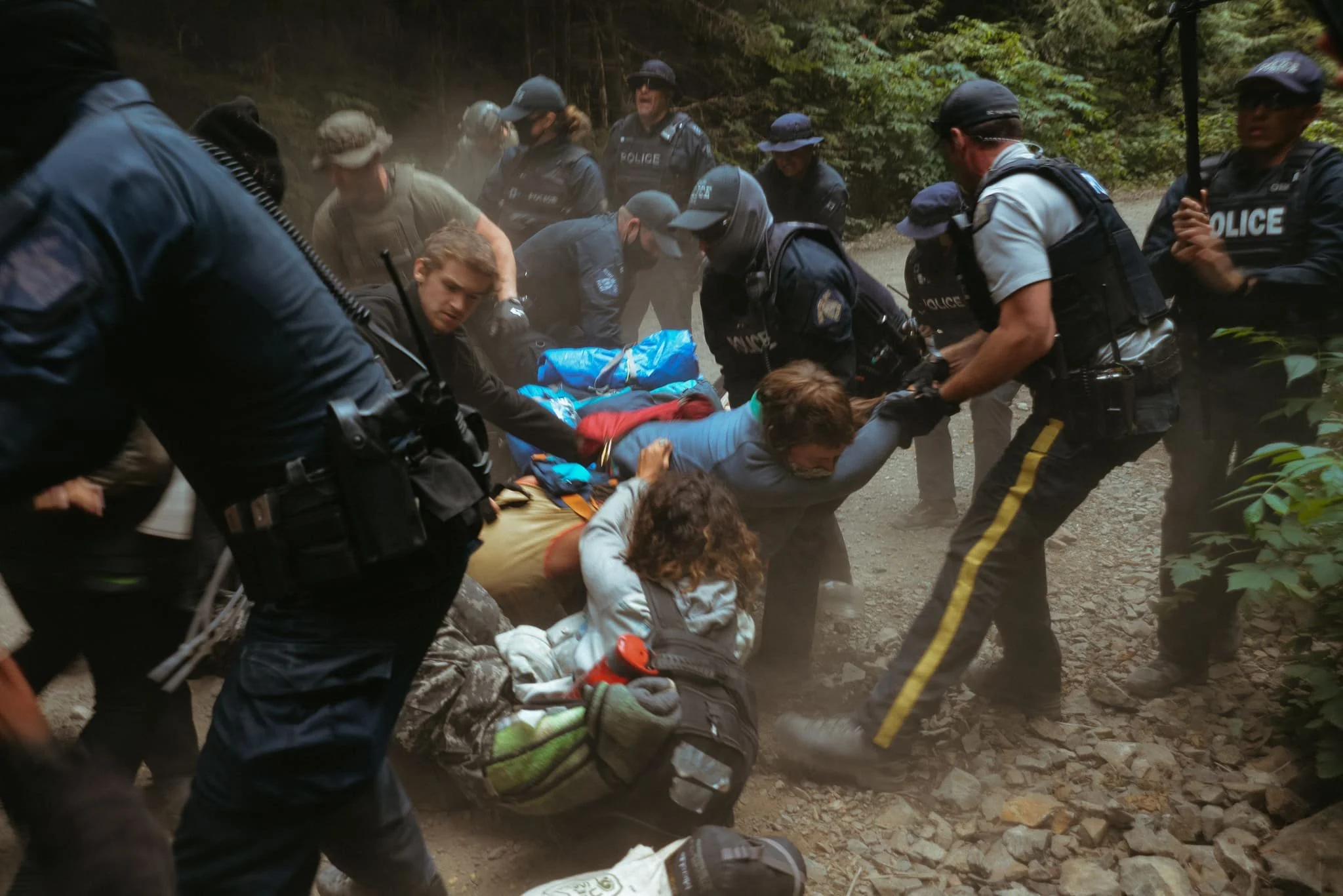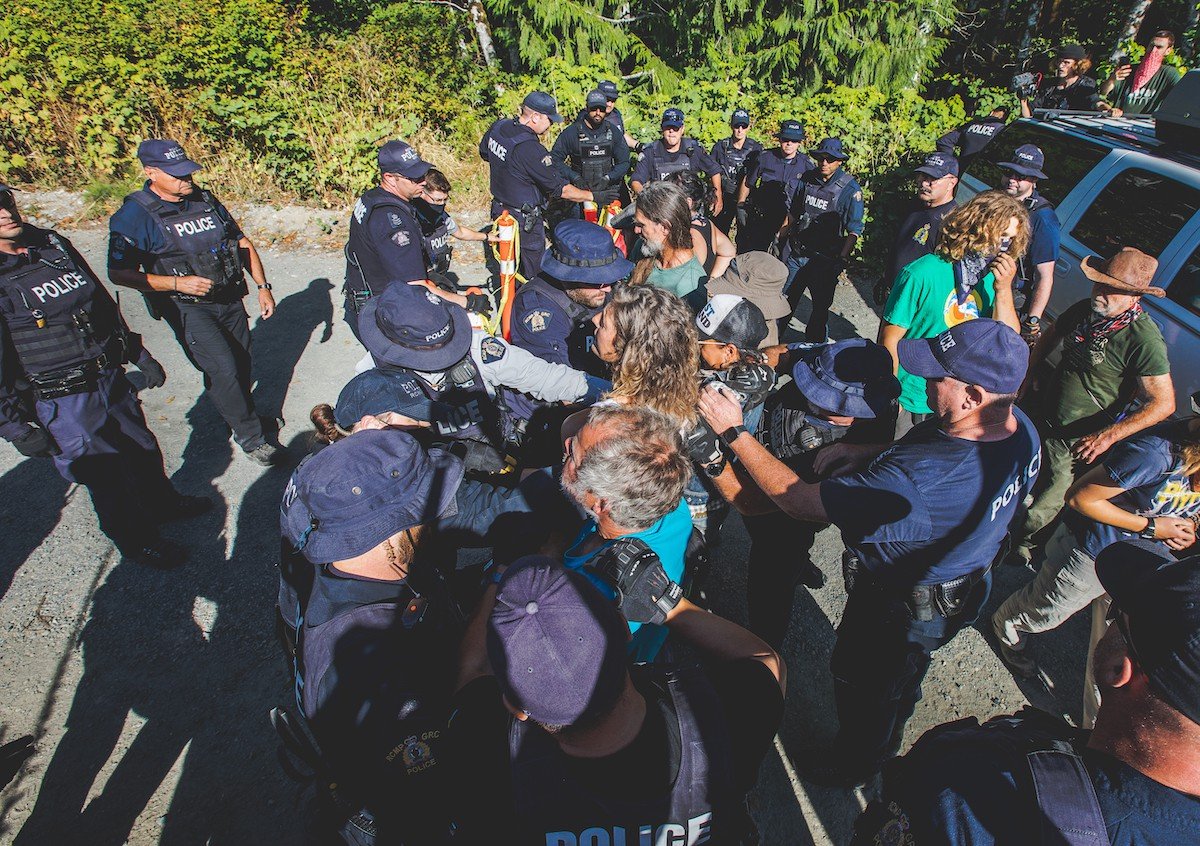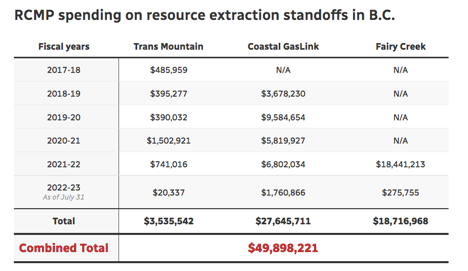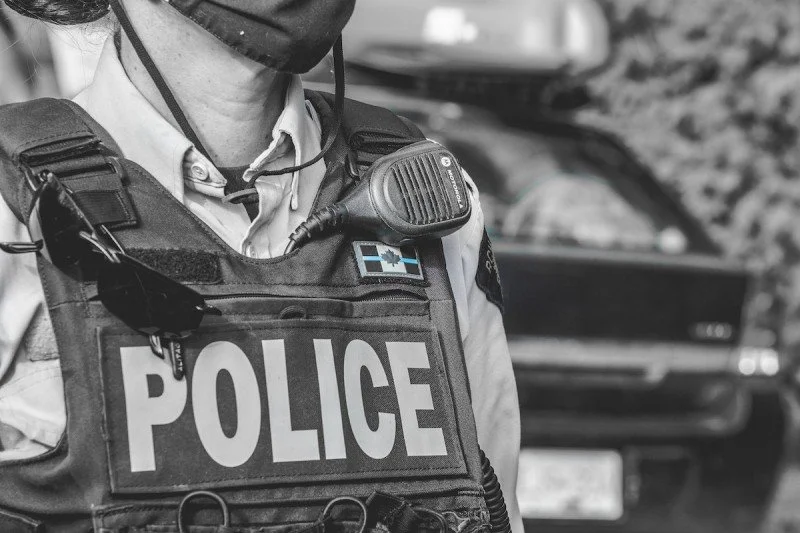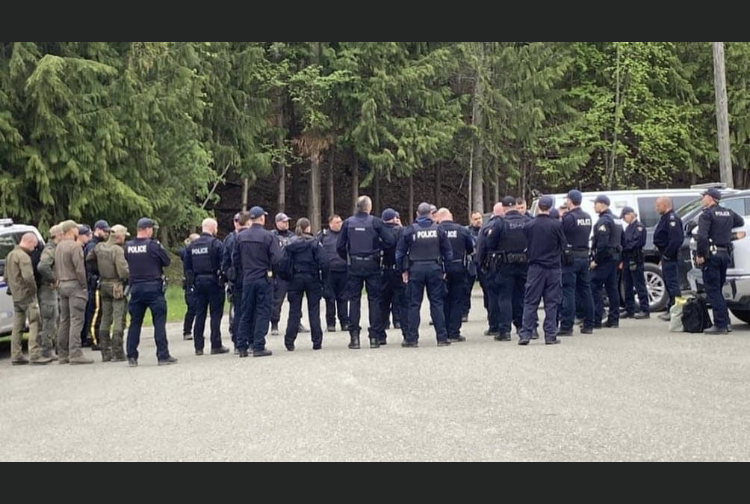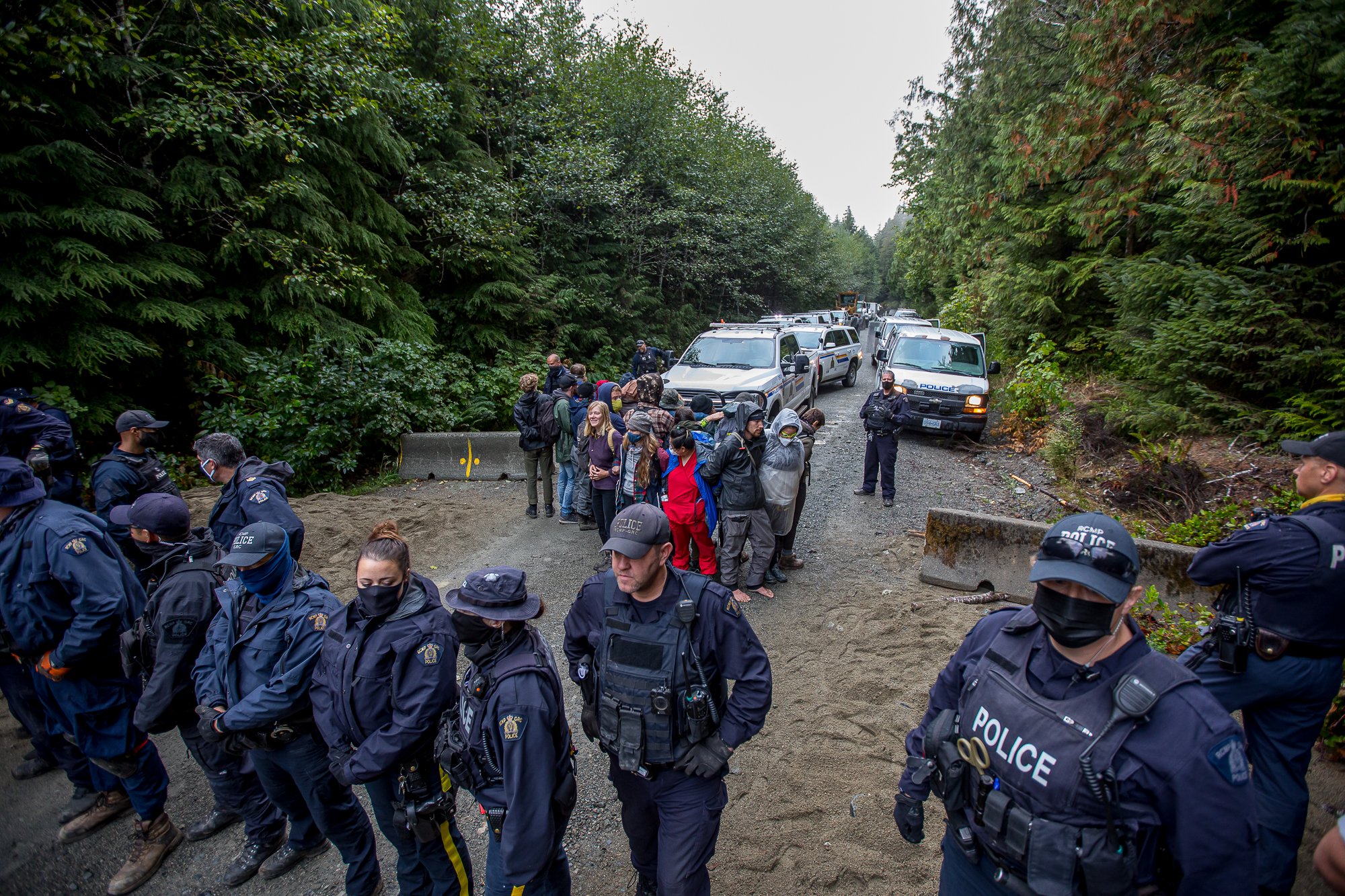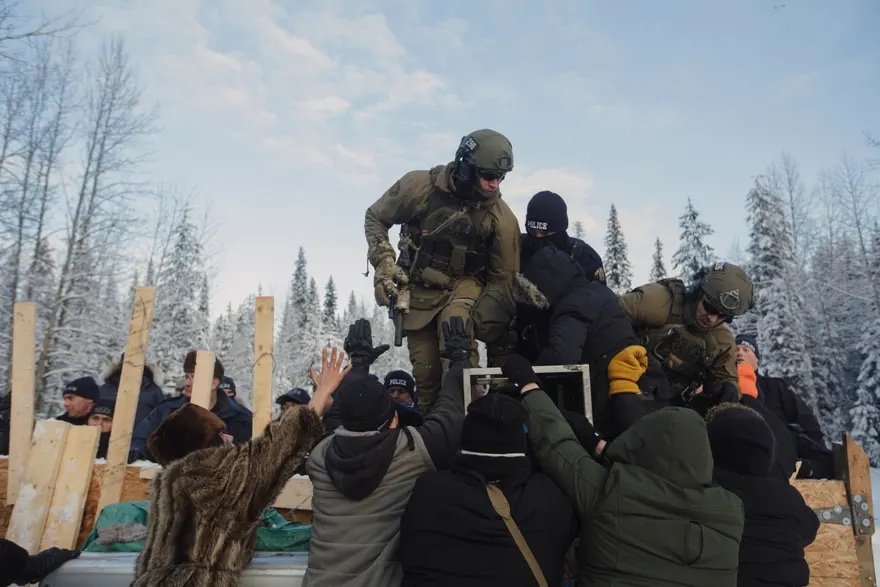
WHO is the C-IRG
Timeline
THE LOVE STORY OF THE CANADIAN STATE AND THE RESOURCE EXTRACTION INDUSTRY
RCMP officers employed in C-IRG units are deployed along systems of command that facilitate expedient mobilisation regardless of the provincial location or industrial context in which they are responding.
The C-IRG is funded by tax dollars at a ratio of 70:30 provincial/federal for each project. $50 million has been spent and another $36 million has been allocated to “administering police responses to unlawful protests and public order events”
tHREAT
The C-IRG unit uses brutal tactics intimidation, torture, brutality, harassment, racism, theft, destruction of property, arbitrary detention, inhumanity, lying and deceit to suppress the voices of people on the land standing up for Indigenous rights and environmental issues.
to
Instead of hearing the concerns of their citizens the Canadian state has chosen to side with industry and use public funds to push projects forward using violence.
Democracy
C-IRG is currently under internal review, but this isn’t good enough. They should never have been created to pave the way for industry in the first place. Stand up to the collusion of state and industry and abolish C-IRG.
“The Community-Industry Response Group (C-IRG) was created in 2017 to provide strategic oversight addressing energy industry incidents and related public order, national security and crime issues.
Consequences of the love story
Trauma, destruction, qausi-fascist regime
2020: BC Civil Liberties Association (BCCLA) submitted a complaint to the Civilian Review and Complaints Commission for the RCMP (CRCC) re: implementing and enforcing a checkpoint and exclusion zone ) in Wet’suwet’en territory
2021: Fairy Creek injunction extension denied citing ‘substantial infringement of civil liberties'
2022: By June 2002, CRCC received over 500 complaints in areas where C-IRG is active. Only a handful were investigated
2022: Civil suit filed by Gidimt’en against RCMP, Minister of Justice, Forsythe Security
2023: CRCC agrees to a systemic review of C-IRG bowing to pressure from land defenders at Fairy Creek, Wet’suwet’en, and Argenta Landing
December 13, 2019: the UN Committee on the Elimination of Racial Discrimination passed a resolution expressing its concern about the construction of the Site C dam (on Treaty 8 territory), the Trans Mountain tar sands pipeline on Secwepemc territory, and the Coastal GasLink fracked gas pipeline on Wet’suwet’en territory. Calls for end to police operations until FPIC secured.
November 2020: Request for an Early Action Urgent Warning procedure was made by the land defenders of the Secwepemc and Wet’suwet’en Nations in relation to the Trans Mountain Pipeline & CGL
November 23, 2021: Request for an Early Warning Urgent Action procedure was requested by the Wet’suwet’en Land Defenders
February 6 2022: Submission to the Expert mechanism on the Rights of Indigenous Peoples, United Nations Human Rights, Office of the High Commissioner by Gidimt’en Checkpoint Re: Militarization of Wet’suwet’en Lands and Canada’s Ongoing Violations
March, 2023: Special Rapporteur on the rights of Indigenous Peoples visiting Wet’suwet’en territory
History of the RCMP
The RCMP first emerged, as the Northwest Mounted Police, from efforts to violently attack Indigenous autonomy in the face of settler colonialism. As the frontier pushed West, what became the RCMP consolidated the system of settler law, private property and corporate resource extraction that it defends to this day. The RCMP also played a central role in policing the tens of thousands of indentured servants brought to create the 'critical infrastructure' of white Canada, and to enforce the segregationist racial regimes encoded in sundown laws, exclusion acts, and the pass system. Finally, the RCMP earned the Royal in its name from the support Canada gave to the British empire in the Boer War of 1900, subjugating Black people under British rule in what became South Africa. In other words, we situate the RCMP's Community-Industry Response Group within a much longer and wider project of elite white rule.
FUNDING
YOUR tax dollars are funding a qausi-facist regime, that perpetuates violence and destruction against you, the environment and Indigenous peoples
In the past 5 years, C-IRG has consumed roughly 50 million tax dollars amid an ever-expanding provincial police budget to harass, surveil, intimidate, and criminalize protesters, land defenders, and Indigenous community members.
RCMP in November 2022 announced $230 million to be invested over the next three years
$194 million to core BC RCMP funding
$36 million to “lead a consistent, integrated and impartially administered police response to unlawful protests and public order events across the province.” - TYEE

origins of c-irg
On, December 26, 2016, The commanding Officer for E-Division “directed that a Gold, Silver, Bronze command structure (C-IRG) be stood up for operational oversight, planning and coordination of Trans Mountain Expansion Pipeline”
Formed in 2017, according to the RCMP “to provide strategic oversight adressing industry incidents and related public order, national security and crime issues” across BC. More specifically confidential documents describe C-IRG formation “in response to large scale resource based industrial operations scheduled in British Columbia” under province’s E Division.
C-IRG’s operations go beyond the energy industry, though. Commander John Brewer told Briarpatch C-IRG had authority over TMX and CGL, but also over fish farms, Fairy Creek, Site C, and others. All resource extraction based projects.

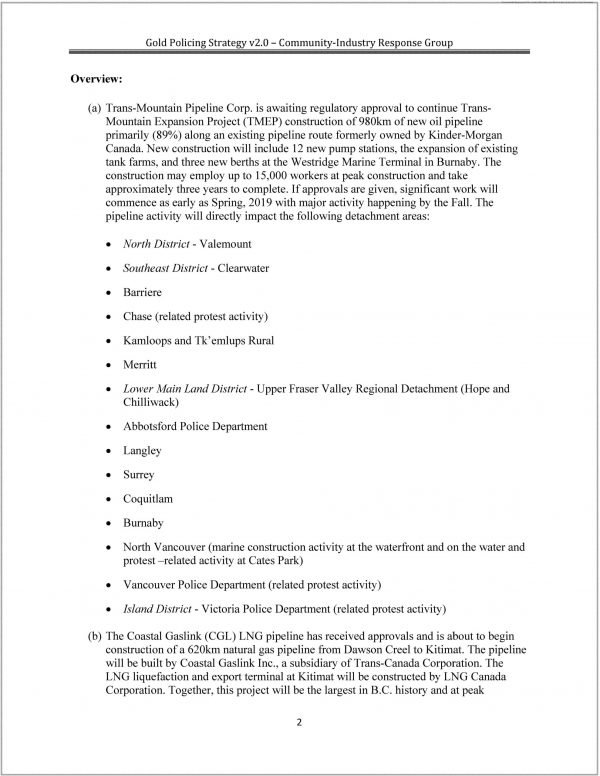
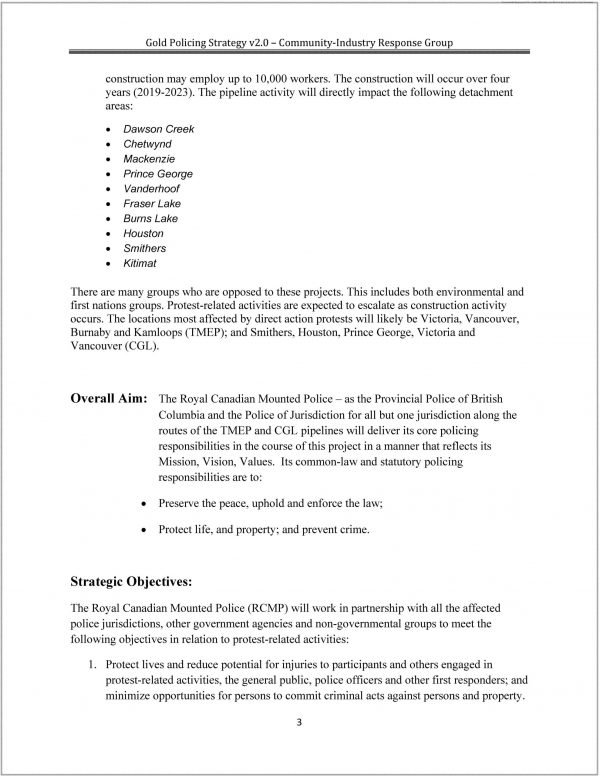
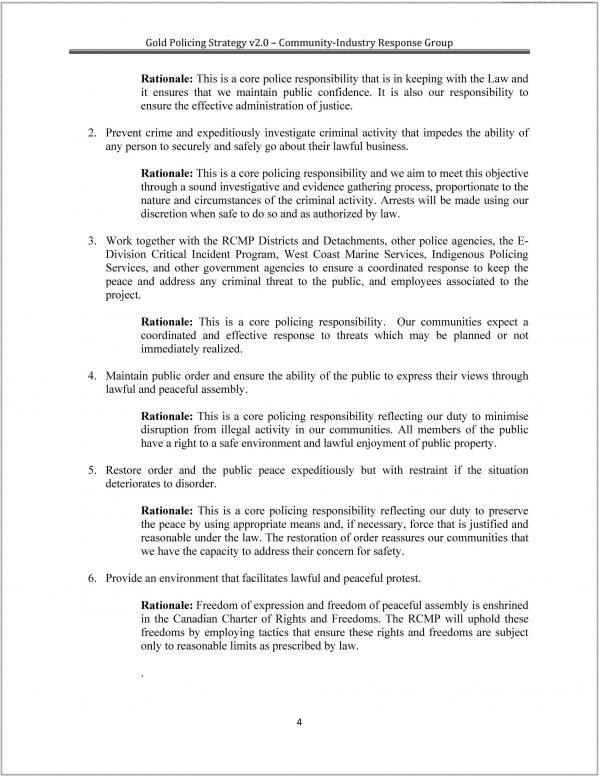
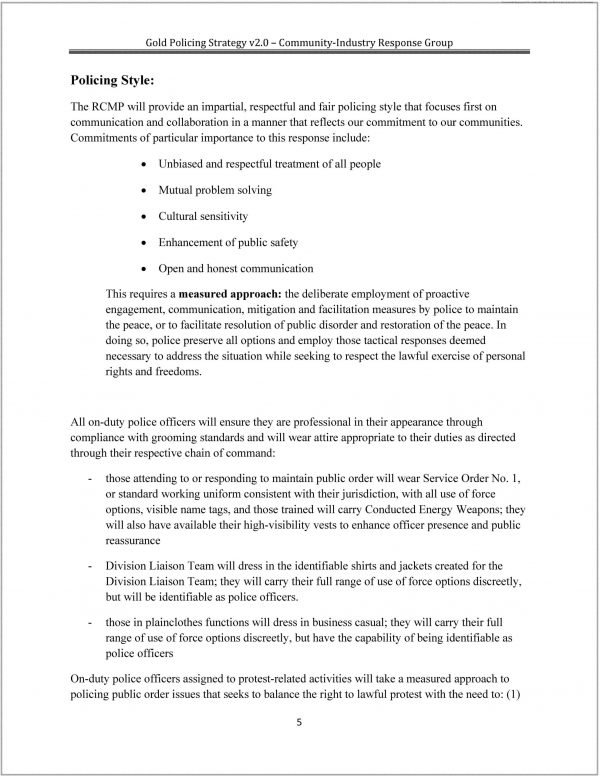
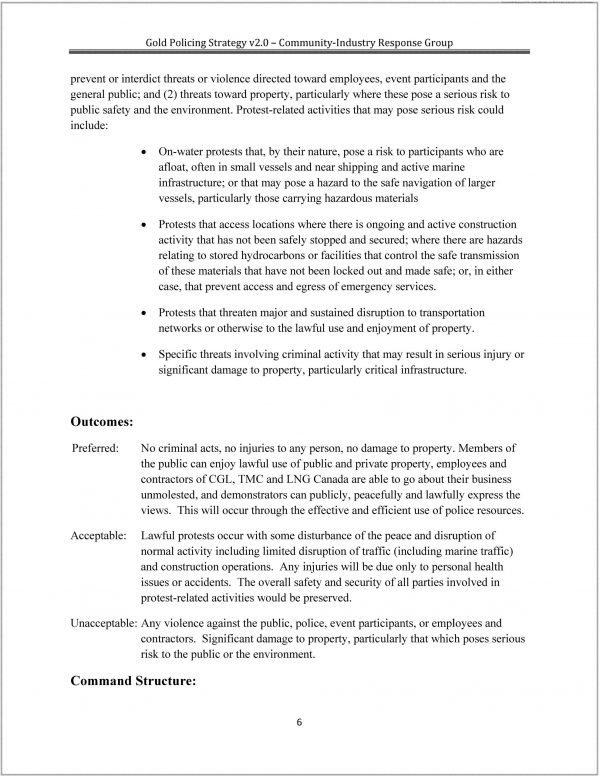
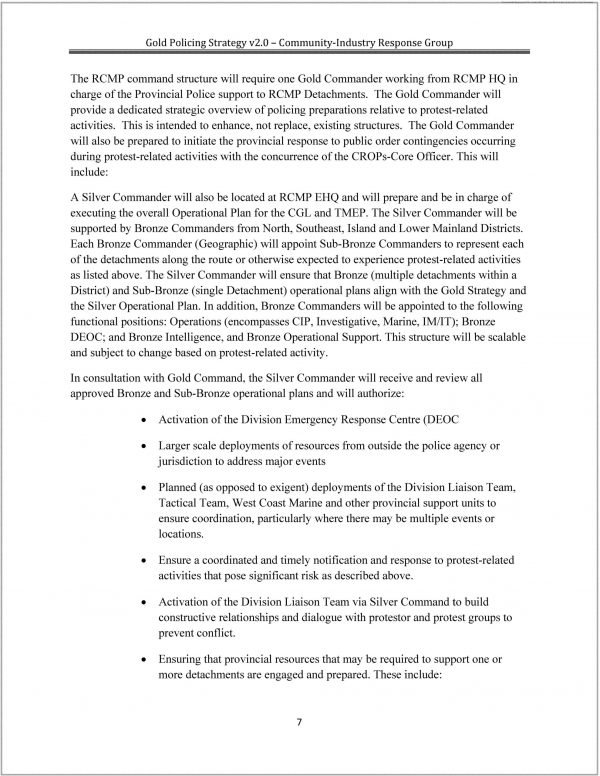
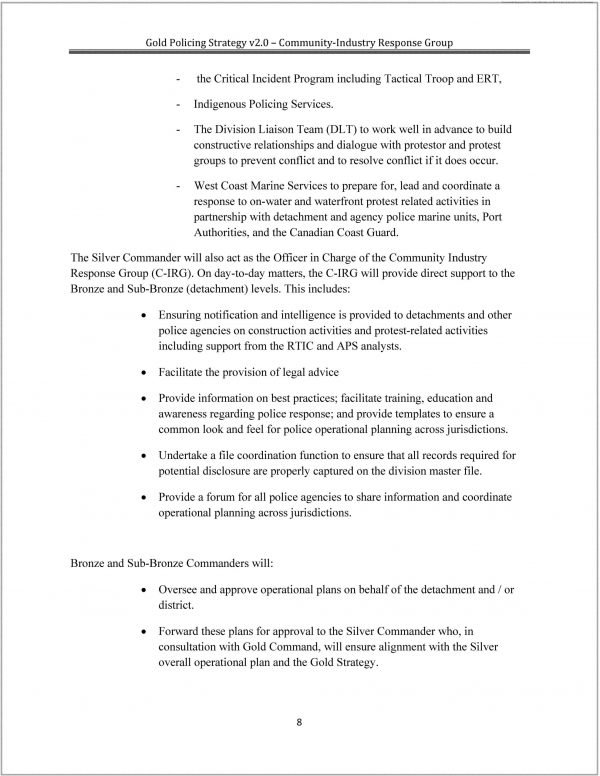
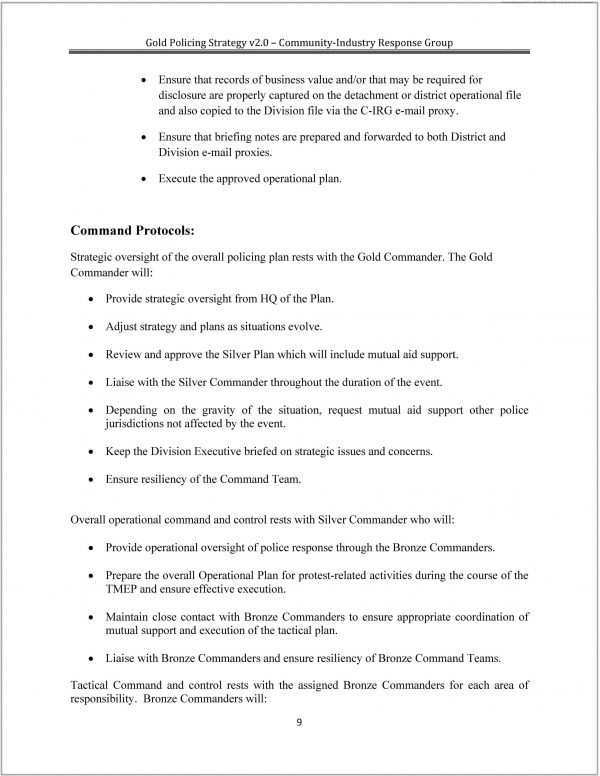
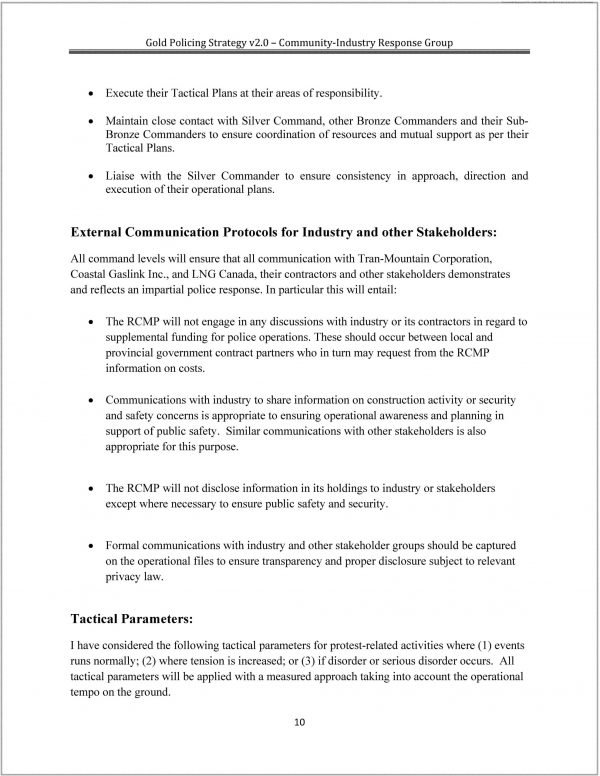
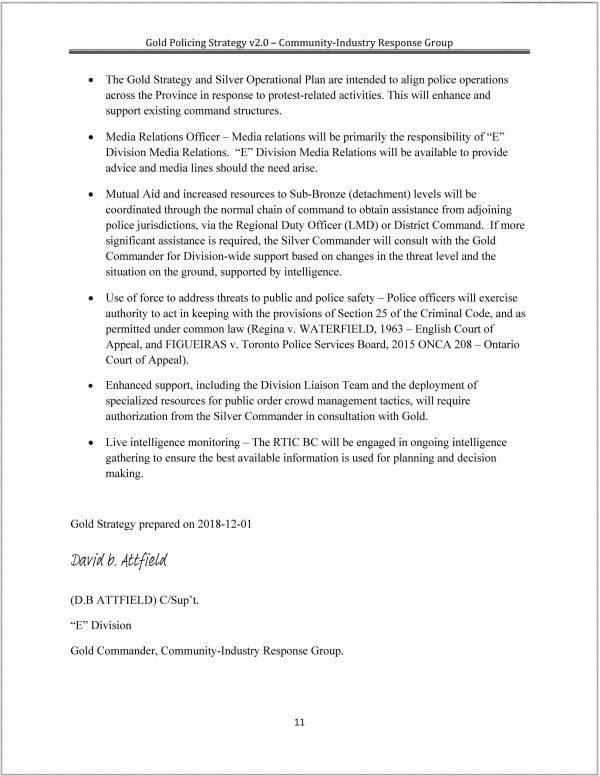
Structure
INTERNAL CHAIN OF COMMAND
GOLD
Administration, filing, approves plans, etc. liaises with police hierarchies, organizations, and governments
SILVER
desk jobs, oversees operations and tactics, works with Bronze, prepares plans for Gold approval
BRONZE
BRONZE: GEOGRAPHIC
North, South-East, Island District, Sub-bronze (Police of Jurisdiction-POJ)
BRONZE: FUNCTIONAL
Intelligence Bronze; Bronze DLT; Bronze Operations; Bronze Operational Support; Bronze IM/IT; Bronze Marine; Bronze Division Emergency Operations Centre (DEOC); Critical Incident Program (CIP) Bronze Command; others as required.
EXTERNAL CHAIN OF COMMAND
RCMP CHAINS OF COMMAND AND ACCOUNTABILITY
‘E’ DIVISION
Governed by the Provincial Police Service Agreement:
7.1. For the purposes of this Agreement, the Commanding Officer will act under the direction of the Provincial Minister in aiding the administration of justice in the Province and in carrying into effect the laws in force therein.
Officials in Ottawa are aware and kept up to date on all information.
PROVINCIAL GOVERNMENT
The Ministry of Public Safety and Solicitor General is responsible for ‘E’ Division
Since 2017, the Minister has been Mike Farnsworth
Also: internal coordination with OP, IRR, EML, ELP, FLN, MOE; This includes through ADM Liaison Civil Unrest meetings, and Critical Incident Procedures meetings.
COORDINATE FEDERAL RESPONSE:
not technically part of a ‘chain of command’ structure, but a high profile RCMP operation will trigger “whole of government” coordination, esp. for media lines and info sharing, but possibly for enforcement decisions, too: Public Safety Canada, Crown Indigenous Relations (CIR), Natural Resources Canada (NRCan), (Works with CAPP), EDC, Works with LNG Canada, CSIS, Prime Ministers Office (PMO), CBSA, Transport Canada, Privy Council, Finance Canada, PPSA
The divisional command structure is usually a temporary, emergency measure to handle particular incidents, such as the Vancouver Olympics or a hostage situation. The logic of the Gold-Silver-Bronze (GSB) system is that it prescribes a chain of command structure to coordinate policing as an integrated response
As far as research shows, using the divisional command structure in this way is unprecedented. Potential disruption to critical infrastructure construction–that can take place over many years, even decades–are being treated as “critical incidents.” This emergency command structure has become a permanent structure for policing Indigenous peoples (and supporters) in BC.
Components
Quick Response Team (QRT)
patrols outside of the injunction enforcement phase
CIRG QRT carries out enforcement duties independent of local detachment operational needs. It provides a surge capacity.
It is made up of Regular Members who are not part of existing specialized units such as Tactical Troop, ERT or Division Liaison Teams. (the CRCC kent county report describes QRTs as smaller units/teams of the larger Tac Troop)
Members receive training in labour law, injunctions, Indigenous culture and environmentalism, and in the use of quads, snow machines, watercraft, operational planning and protest management.
Divisional Liaison Team (DLT)
Community outreach, and often acts as an intermediary between protesters and resource companies.
Training in relationship building, establishing “trust”, and “nurturing respect”.
Charged with working well in advance to build constructive relationships with protestors
Most of them work full time as First Nation Police, but were not used in the local communities they serve as it was seen that this might damage their relationships and reputation.
DLT Team members wear identifiable gray collared golf shirts, dark gray jackets marked police, and hats. They carry their full range of use of force options discreetly.
They share observations and information obtained from interactions via Bronze Commander (DLT); Bronze shares up the chain. They also receive intel via their Bronze Commander to inform their interactions. Key part of Gold Plan - direct lines to Gold Command
Based upon PLT units in Ontario, established after Ipperwash. An RCMP Ediv Unit from 2012, the Indigenous Policing Community Liaison Officer was described as a nascent component of The DLT.
Tactical Troop Public Order Unit (TAC Troop)
Subdivided in specialized sections e.g., arrest team, crowd control, etc
Emergency Response Team (ERT)
specialized unit trained in the use of weapons and other tactics and skills including Penetrating blockades.
May also provide observation / intelligence function
Intelligence
Real Time Intelligence Centre (RTIC)-BC
Provides continuous live intelligence monitoring to inform planning and decision-making. The RTIC-BC is a multijurisdictional partnership including RCMP, CBSA, municipal forces, and Correctional services. It was established in 2019 and operates 24-7 and has access to 30 databases. Works with CIRG but relationship is not fully clear
Integrated National-Security Enforcement Team (INSET)
Federal Units with command based in Ottawa and until in each Division/Provinces, Generally focused on Terrorism, Has worked with CIRG (during Injunction Phase)
TMEP and CGL were designated as national critical infrastructure”.
collecting evidence for arrests

